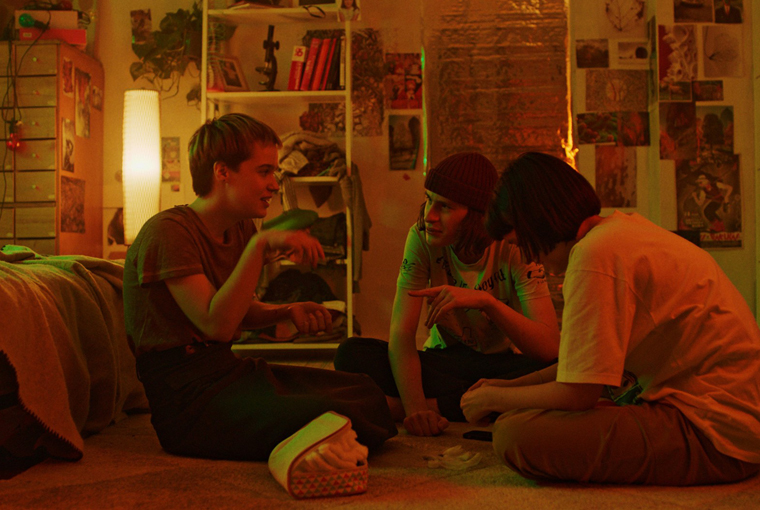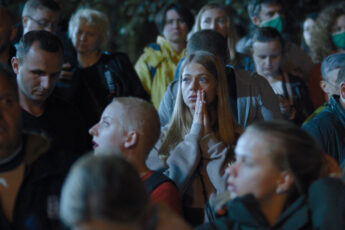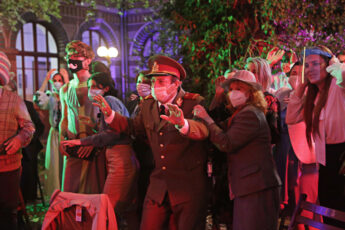Why Must I Be a Teenager in Love?
Kateryna Gornostai’s Stop-Zemlia (2021)
Vol. 114 (April 2021) by Zoe Aiano
It’s the classic high school romance: girl loves boy, boy barely acknowledges the existence of girl. As graduation draws ever closer, the chances of the miracle taking place and the boy experiencing a revelation slowly diminish. This simple plot provides the frame for Kateryna Gornostai’s Stop-Zemlia, an exploration of all of the angst and joy that comes with being a teenager in the era of Instagram.
The girl at the heart of the story is the doe-eyed, shyly charming Masha (Maria Fedorchenko), part of a trio of tight-knit friends together with Senia (Arsenii Markov), an axolotl-owning skater boy who never takes off his hat, even indoors, and Yana (Yana Isaienko), who is effortlessly cool and seemingly self-possessed yet suffers from depression. Masha’s whole physicality embodies the awkwardness of adolescence, her tiny frame draped in 90s-throwback knitwear and trudging through space with a defensive slouch. Indeed, all the non-actors are excellently cast and bring an air of authenticity to the palpable atmosphere of hormones and tension (as well as occasional fun and reckless irresponsibility).
The object of Masha’s affections is Sasha (Oleksandr Ivanov) who, like many a quintessential schoolroom crush, has little discernable personality. He’s part of the cool gang but not a particularly high-ranking member, making him somewhat of a jock but not a terrible one. In his home life, we see him taking piano lessons (so definitely not a total jock) and struggling to get along with his single mother, whose sadness at the prospect of losing him manifests as anger and frustration. For the most part, however, he remains inscrutably reticent. In the meantime, as Masha wallows in her feelings without summoning the courage to actually approach him, Senia realizes he in turn has fallen for Masha, but he decides to keep it to himself for the sake of their friendship and even encourages Masha to be more proactive in her pursuit of Sasha.
In a luxury very rarely afforded to Eastern European cinema, the fact of Stop-Zemlia being set in Ukraine is essentially unimportant. Although the war is mentioned briefly and harrowingly, the focus is squarely on the universal experience of being on the cusp of adulthood. If anything, the references to armed conflict fit into a broader subtext of trauma that recurs throughout the film in various forms. While the kids, especially Masha’s clique, are all well informed and mindful of progressive thinking on issues such as environmentalism and sexual orientation, the film nevertheless makes it clear that they are each damaged in their own way, and no-one makes it out of childhood unscathed. Similarly, it also makes a point of enumerating all the different ways a parent-teenager relationship can be strained without laying the blame for it with either party.
For the most part, the film adopts a soft, crisp aesthetic with a color palette that at times reinforces the wintery setting, while at others it uses the unnatural lighting typical of glowing electronic devices to create the uncanny mood of a liminal world, especially in the inner sanctums of the kids’ bedrooms or during the climactic prom scene. As an extension of this, a series of dream sequences pushes the stylization further, revealing Masha’s hopes and dreams.
The most interesting and effective break from the standard storytelling mode comes from a series of improvised interviews of the characters, shot in documentary style against a simple photography screen. At first, this is slightly confusing as the actors all have different hairstyles and it takes some time to establish correlation with the characters in the film, and indeed it is never fully established to what extent they are speaking as themselves and to what extent they are staying in role. In any case, this is when the young stars all really have the chance to shine, revealing both their vulnerability and reflexivity. This is also the part in which many of the funniest and most endearing lines are delivered, as the cast describe their humble experiences of love in grandiose, earth-shattering terms.
Gornostai’s film isn’t particularly revolutionary, but teenage emotions aren’t revolutionary, even if they may seem like they are to those experiencing them. However, by taking an unpretentious story with a gradually sloping dramatic arc, it creates space for the characters to be fully fleshed out instead of being reduced to archetypes, like depictions of teenagers so often are. It paints a subtle but deep portrait of a community at a poignant moment of transition in their lives that captures all the collective exuberance and individual frailty of this stage of youth. Moreover, by rejecting conventional happy ends and false closure, it also avoids patronizing viewers with the cliché that your school days will go on to define the rest of your life. Instead, it is clear from the many scenes of tenderness and intimacy imbued with a palpable tactile warmth that these kids have a lot more ahead of them.




Leave a Comment